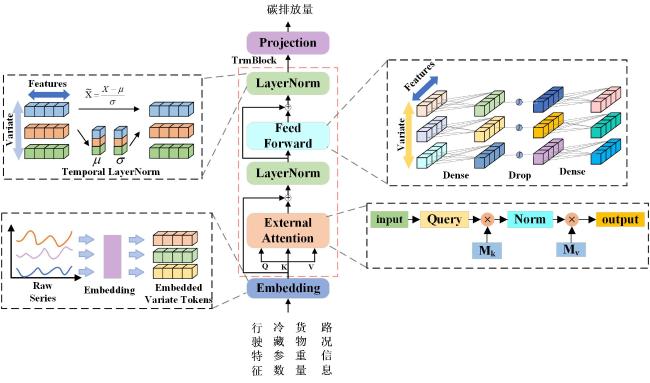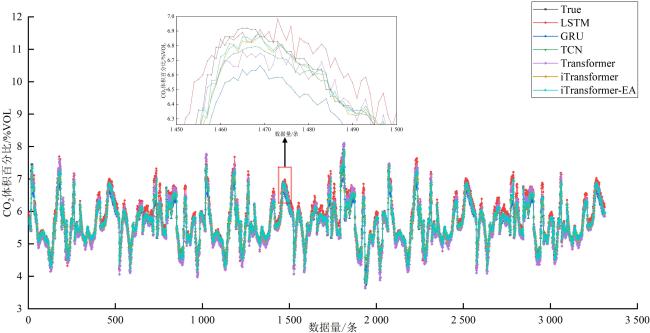[Objective] The dynamic prediction of carbon emission from cold chain distribution is an important basis for the accurate assessment of carbon emission and its green credit grade. Facing the fact that the carbon emission of vehicles is affected by multiple factors, such as road condition information, driving characteristics, refrigeration parameters, etc., a dynamic prediction model of carbon emission was proposed from refrigerated vehicles that integrates multi-source information. [Methods] The backbone feature extraction network, neck feature fusion network and loss function of YOLOv8s was firstly improved. The full-dimensional dynamic convolution was introduced into the backbone feature extraction network, and the multidimensional attention mechanism was introduced to capture the contextual key information to improve the model feature extraction capability. A progressive feature pyramid network was introduced into the feature extraction network, which reduced the loss of key information by fusing features layer by layer and improved the feature fusion efficiency. The road condition information recognition model based on improved YOLOv8s was constructed to characterize the road condition information in terms of the number of road vehicles and the percentage of pixel area. Pearson's correlation coefficient was used to compare and analyze the correlation between carbon emissions of refrigerated vehicles and different influencing factors, and to verify the necessity and criticality of the selection of input parameters of the carbon emission prediction model. Then the iTransformer temporal prediction model was improved, and the external attention mechanism was introduced to enhance the feature extraction ability of iTransformer model and reduce the computational complexity. The dynamic prediction model of carbon emission of refrigerated vehicles based on the improved iTransformer was constructed by taking the road condition information, driving characteristics (speed, acceleration), cargo weight, and refrigeration parameters (temperature, power) as inputs. Finally, the model was compared and analyzed with other models to verify the robustness of the road condition information and the prediction accuracy of the vehicle carbon emission dynamic prediction model, respectively. [Results and Discussions] The results of correlation analysis showed that the vehicle driving parameters were the main factor affecting the intensity of vehicle carbon emissions, with a correlation of 0.841. The second factor was cargo weight, with a correlation of 0.807, which had a strong positive correlation. Compared with the vehicle refrigeration parameters, the road condition information had a stronger correlation between vehicle carbon emissions, the correlation between refrigeration parameters and the vehicle carbon emissions impact factor were above 0.67. In order to further ensure the accuracy of the vehicle carbon emissions prediction model, The paper was selected as the input parameters for the carbon emissions prediction model. The improved YOLOv8s road information recognition model achieved 98.1%, 95.5%, and 98.4% in precision, recall, and average recognition accuracy, which were 1.2%, 3.7%, and 0.2% higher than YOLOv8s, respectively, with the number of parameters and the amount of computation being reduced by 12.5% and 31.4%, and the speed of detection being increased by 5.4%. This was due to the cross-dimensional feature learning through full-dimensional dynamic convolution, which fully captured the key information and improved the feature extraction capability of the model, and through the progressive feature pyramid network after fusing the information between different classes through gradual step-by-step fusion, which fully retained the important feature information and improved the recognition accuracy of the model. The predictive performance of the improved iTransformer carbon emission prediction model was better than other time series prediction models, and its prediction curve was closest to the real carbon emission curve with the best fitting effect. The introduction of the external attention mechanism significantly improved the prediction accuracy, and its MSE, MAE, RMSE and R2 were 0.026 1 %VOL, 0.079 1 %VOL, 0.161 5 %VOL and 0.940 0, respectively, which were 0.4%, 15.3%, 8.7% and 1.3% lower, respectively, when compared with iTransformer. As the degree of road congestion increased, the prediction accuracy of the constructed carbon emission prediction model increased. [Conclusions] The carbon emission prediction model for cold chain distribution under multi-source information fusion proposed in this study can realize accurate prediction of carbon emission from refrigerated vehicles, provide theoretical basis for rationally formulating carbon emission reduction strategies and promoting the development of low-carbon cold chain distribution.
















